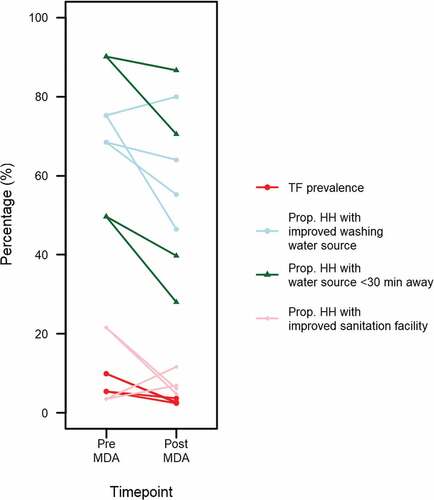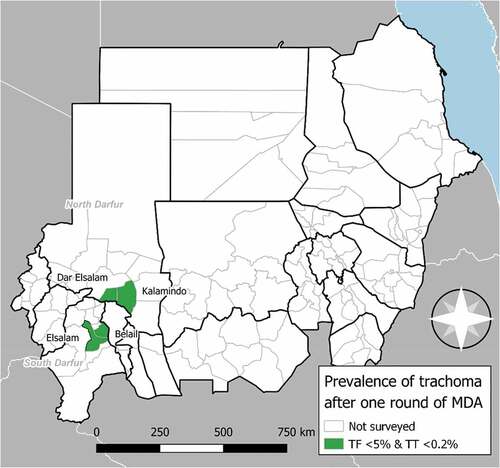Figures & data
Table 1. Proportion of the enumerated population who were enumerated and examined in four evaluation units (EUs) of Darfur region, Sudan, December 2018–January 2019.
Figure 1. Difference in adjusted prevalence of trachomatous inflammation—follicular (TF) in 1–9-year-olds, proportion of households with an improved washing water source, proportion of households with a washing water source within a 30-minute return journey of the household and proportion of households with an improved latrine in four evaluation units of Sudan. Pre-antibiotic mass drug administration (MDA) survey data collected as part of the Global Trachoma Mapping Project, 2014 − 2015.Citation6 Post-MDA data collected in December 2018–January 2019. There are two post-MDA estimates associated with each pre-MDA estimate due to the splitting of each pre-MDA evaluation unit (EU) into two EUs for post-MDA surveys. Prop. HH: Proportion of households

Figure 2. Prevalence of trachomatous inflammation – follicular (TF) in 1–9-year-olds and trachomatous trichiasis (TT) unknown to the health system in ≥15-year-olds in four evaluation units of Sudan. A single round of azithromycin mass drug administration (MDA) took place in these localities in 2017 and the surveys were completed in December 2018–January 2019. The boundaries and names shown and the designations used on this map do not imply the expression of any opinion whatsoever on the part of the authors, or the institutions with which they are affiliated, concerning the legal status of any country, territory, city or area or of its authorities, or concerning the delimitation of its frontiers or boundaries.

Table 2. Prevalence of trachomatous inflammation – follicular and trachomatous trichiasis in four evaluation units (EUs) of Darfur region, Sudan, December 2018–January 2019.
Table 3. Water, sanitation, and hygiene infrastructure coverage in four evaluation units (EUs) of Darfur region, Sudan, showing both the pre-antibiotic mass drug administration (MDA) dataCitation6 and post-MDA impact survey data (December 2018–January 2019). Improvement status of latrines and water sources was classified using United Nations Childrens' Fund/World Health Organization Joint Monitoring Programme definitions.Citation16 Handwash station data were recorded where there was a station within 15 m of an improved or unimproved latrine but not where there was no latrine.
